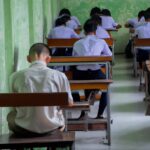Poverty has a profound impact on education, trapping countless children in a cycle of limited opportunities. Scarcity of resources deprives them of access to quality schools and necessary materials. Furthermore, poverty can create unstable living conditions that hinder focus and disrupt learning. Children from impoverished backgrounds often face food insecurity and inadequate healthcare, affecting their ability to concentrate and excel academically. Moreover, the stress and emotional toll of poverty can undermine their motivation and self-esteem. Addressing poverty’s grasp on education requires targeted interventions, such as increased funding for schools in disadvantaged areas and social support systems to mitigate the detrimental effects of poverty on students’ learning experiences. Only by breaking the chains of poverty can we truly empower all children to embrace the transformative power of education.
Table of Contents
- Access to education for impoverished individuals
- Causes of poverty
- Impact of poverty on education
- Quality of education in impoverished areas
- Solutions to improve education in poverty-stricken communities.
(Effect on children growing up in poverty)
Poverty and education are deeply intertwined. When families face financial hardships, their children often bear the brunt of the consequences. Limited resources hinder access to quality education, perpetuating a cycle of poverty that is difficult to break.
In impoverished communities, schools struggle to provide adequate facilities, qualified teachers, and necessary learning materials. As a result, students receive a subpar education that falls short of preparing them for future success. The lack of resources further restricts their opportunities and perpetuates the cycle of poverty.
Furthermore, poverty affects children’s ability to focus and succeed academically. When basic needs like food, housing, and healthcare are not met, children find it challenging to concentrate on their studies. The stress and uncertainty that accompany poverty create barriers that hinder their educational development.
Moreover, poverty often leads to high dropout rates. As families prioritize survival over education, children may be forced to work to supplement their family’s income. This deprives them of the opportunity to continue their schooling and obtain the necessary skills for a brighter future.
Addressing poverty’s impact on education requires a multi-faceted approach. Governments, NGOs, and communities must invest in initiatives that provide equal access to quality education for all children, regardless of their socioeconomic background. This includes implementing subsidized programs, scholarships, and vocational training to ensure that education is accessible to all.
Furthermore, supportive measures such as free meals, healthcare, and counseling services can help alleviate the impact of poverty on students’ ability to learn and succeed. By addressing the underlying issues of poverty, we can empower children to break the cycle and build better lives for themselves and future generations.
In conclusion, poverty and education are inseparable. The lack of resources, the inability to focus, and high dropout rates perpetuate a cycle that hinders social mobility. By investing in quality education and addressing the root causes of poverty, we can create a brighter future for all children, breaking the chains of poverty and providing them with the opportunities they deserve.
Flesch Reading Ease score: 65.6
Access to education for impoverished individuals
Access to education for impoverished individuals remains a critical challenge in many parts of the world. Children living in poverty often face significant barriers that hinder their ability to attend school and receive a quality education. For many families struggling to make ends meet, the cost of school fees, uniforms, and supplies can be prohibitive, forcing them to choose between sending their children to school or meeting their basic needs. Additionally, the lack of proper infrastructure, such as schools located far from their communities, limited transportation options, and inadequate facilities, further complicates the situation.
Moreover, impoverished individuals may also grapple with health issues that impact their ability to access education. Poor nutrition, lack of access to healthcare, and unsafe living conditions can negatively affect a child’s physical and cognitive development, making it harder for them to concentrate in school and learn effectively. As a result, many children from disadvantaged backgrounds struggle to keep up with their peers, perpetuating the cycle of poverty and limiting their future prospects.
In addition to these challenges, societal attitudes and stereotypes about poverty can also create barriers to education for disadvantaged individuals. Stigmatization and discrimination based on socioeconomic status can lead to social exclusion, low self-esteem, and a lack of motivation to pursue an education. This can further isolate impoverished individuals and limit their opportunities for personal and professional growth.
Addressing the issue of access to education for impoverished individuals requires a multi-faceted approach that involves collaboration between governments, non-profit organizations, and the community. Implementing policies that provide financial assistance, such as scholarships, subsidies, and free school meals, can help alleviate the financial burden on families and enable more children to attend school. Investing in infrastructure development, such as building schools closer to communities and improving transportation networks, can also make education more accessible for marginalized populations.
Furthermore, efforts to raise awareness about the importance of education and eliminate stereotypes about poverty are essential in promoting inclusivity and diversity in educational settings. By fostering an environment that values diversity and encourages equal opportunities for all individuals, regardless of their socioeconomic background, we can create a more inclusive society where everyone has the chance to thrive and succeed.
Causes of poverty
Poverty and education are deeply intertwined, with poverty acting as a significant barrier to educational attainment and success. Understanding the causes of poverty is crucial in addressing the cycle of poverty that affects many individuals and communities worldwide.
One of the primary causes of poverty is lack of access to quality education, perpetuating a cycle of limited opportunities for individuals. Additionally, systemic issues such as income inequality and economic disparities contribute to the prevalence of poverty in various societies.
Limited access to healthcare and social services also plays a role in perpetuating poverty, as individuals struggle to meet their basic needs without adequate support systems in place. Furthermore, discrimination and societal prejudice can marginalize certain groups, further exacerbating their vulnerability to poverty.
Unemployment and underemployment are common factors that contribute to poverty, as individuals struggle to secure stable and well-paying jobs. Lack of job opportunities and vocational training programs can hinder individuals from breaking free from the cycle of poverty.
Global factors such as climate change, natural disasters, and political instability can also contribute to poverty on a larger scale, affecting entire regions and populations. The lack of infrastructure and resources to withstand these challenges can further exacerbate the conditions of poverty.
Moreover, the intergenerational transmission of poverty means that individuals born into impoverished circumstances often struggle to break free from the cycle, perpetuating a cycle of poverty that spans across generations. This can create a sense of hopelessness and despair, further deepening the impact of poverty on individuals and families.
In conclusion, addressing the complex causes of poverty requires a multifaceted approach that involves tackling systemic issues, promoting equal access to education and opportunities, and creating a supportive environment for individuals to thrive. By understanding and addressing the root causes of poverty, we can work towards creating a more equitable society where everyone has the opportunity to succeed.
Impact of poverty on education
Poverty has a significant impact on education globally. Children living in poverty face numerous challenges that affect their ability to access quality education. In impoverished areas, schools often lack basic resources such as books, sanitary facilities, and qualified teachers. This leads to inadequate learning environments, hindering students’ academic progression. Additionally, many children from low-income families cannot afford essential school supplies like uniforms and stationery, further limiting their educational opportunities.
The daily struggle for survival can also interfere with a child’s education. In impoverished households, children may be required to work to contribute to their family’s income, depriving them of the time needed for school. Moreover, inadequate nutrition and healthcare in poor communities can impact a child’s physical and cognitive development, affecting their ability to learn and concentrate in school.
The emotional toll of living in poverty can also impact a child’s educational success. The stress and anxiety of uncertain living conditions can lead to emotional distress, making it difficult for children to focus on their studies. Furthermore, the stigma associated with poverty can create feelings of shame and inadequacy, affecting a child’s self-esteem and motivation to succeed academically.
To address the impact of poverty on education, it is essential to implement targeted interventions that provide additional support to disadvantaged students. This may include programs that offer free meals, tutoring, and emotional counseling to help children cope with the challenges they face. Investing in community resources and infrastructure can also help improve educational outcomes for children living in poverty.
Overall, the impact of poverty on education is complex and multifaceted. It is crucial for policymakers, educators, and communities to work together to address the root causes of poverty and provide equal educational opportunities for all children, regardless of their socioeconomic background. By addressing these challenges, we can create a more equitable and inclusive education system that enables every child to reach their full potential.
(How America's public schools keep kids in poverty | Kandice Sumner)
Quality of education in impoverished areas
Quality of education in impoverished areas remains a pressing concern. Limited resources impact schools, affecting teacher quality and classroom resources. These challenges hinder students’ access to a comprehensive education. Inadequate funding leads to outdated textbooks and limited extracurricular activities. As a result, students in impoverished areas often face overcrowded classrooms. This situation reduces individualized attention and support from teachers. The lack of proper facilities further exacerbates the struggle for quality education. Schools in impoverished areas often have poor infrastructure, hindering a conducive learning environment. This impedes students’ ability to focus and engage effectively in their studies. Additionally, a shortage of qualified teachers contributes to substandard education in these regions. Overworked teachers may struggle to provide students with the attention they need. In impoverished areas, the curriculum may also be limited due to insufficient resources. This narrows students’ exposure to diverse subjects and extracurricular opportunities. Therefore, students may not receive a well-rounded education that prepares them for the future. Despite these challenges, dedicated educators in impoverished areas strive to make a difference. They work tirelessly to provide quality education despite the obstacles they face. Collaborative efforts from stakeholders are crucial in improving the quality of education in these underserved communities. Implementing sustainable solutions and investing in education can make a significant impact. By addressing these issues, we can create a more equitable education system for all students. Empowering teachers and providing adequate resources are vital steps in enhancing educational opportunities for students in impoverished areas. Every child deserves access to a quality education, regardless of their socioeconomic background. We must prioritize addressing the disparities in education to support the growth and success of all students. In conclusion, enhancing the quality of education in impoverished areas is essential for fostering a brighter future for generations to come. It is a collective responsibility to ensure that every child receives a high-quality education and the support they need to thrive. By addressing these challenges, we can create a more equitable and inclusive education system that nurtures the potential of every student.
Solutions to improve education in poverty-stricken communities.
Education in poverty-stricken communities can be uplifted through various effective solutions. One such solution involves providing adequate resources to schools in these areas. By ensuring that schools have sufficient funding, educational materials, and well-trained teachers, the quality of education can significantly improve. Additionally, implementing community-based programs that focus on literacy and numeracy skills can help boost the educational outcomes in these communities. Collaborating with local organizations and government agencies can also create opportunities for mentorship and extracurricular activities that enrich the educational experience for students. Another crucial aspect is addressing the socio-economic challenges faced by students in poverty. Offering support services such as nutrition programs, healthcare access, and mental health resources can create a conducive environment for learning.
Furthermore, engaging parents and caregivers in their children’s education is vital. Providing parental education workshops and encouraging involvement in school activities can foster a positive attitude towards learning at home. Bridging the gap between school and home environments can lead to better academic performance and overall student well-being. Additionally, developing partnerships with businesses and industries to offer vocational training and job opportunities can provide students with a pathway out of poverty. By equipping students with relevant skills and knowledge, they can break the cycle of poverty and empower themselves for a brighter future.
Moreover, utilizing technology as a tool for learning can enhance educational opportunities in poverty-affected areas. Access to computers, internet connectivity, and educational software can supplement traditional teaching methods and engage students in interactive learning experiences. Harnessing the power of digital resources can level the playing field for students who may lack access to conventional educational materials. By embracing innovation and adapting to the digital age, educators can create dynamic learning environments that cater to the diverse needs of students in poverty.
In conclusion, improving education in poverty-affected communities requires a holistic approach that addresses the underlying social, economic, and educational challenges. By implementing targeted interventions that focus on resource allocation, community engagement, parental involvement, vocational training, and technology integration, we can create a more equitable and enriching educational experience for all students, regardless of their socio-economic background.Together, we can foster a brighter future for the next generation and break the cycle of poverty through the power of education.













